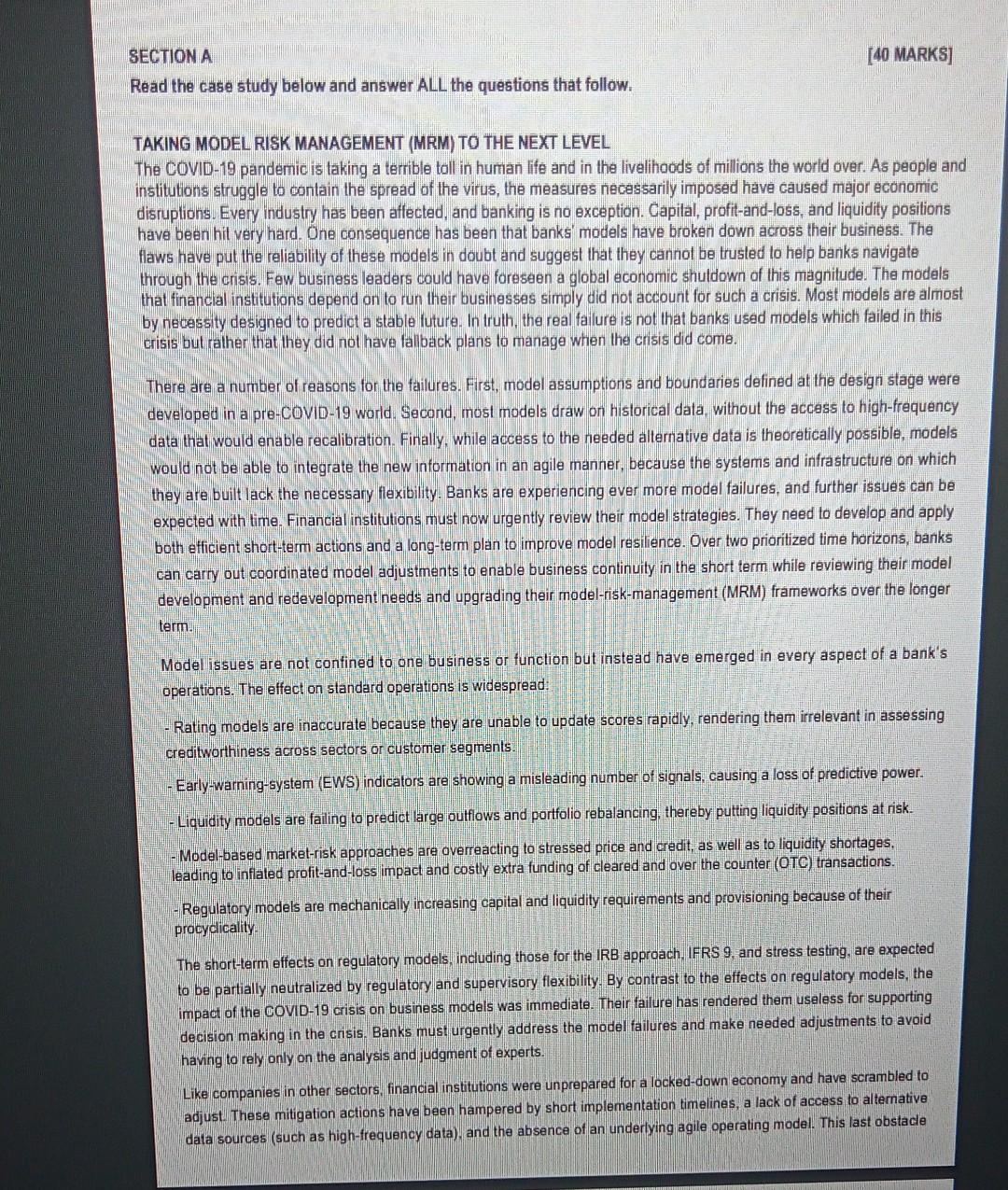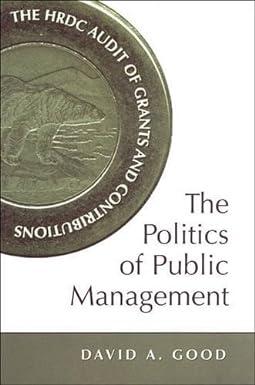Answered step by step
Verified Expert Solution
Question
1 Approved Answer
BECTION A [40 MARKS] Read the case study below and answer ALL the questions that follow. TAKING MODEL RISK MANAGEMENT (MRM) TO THE NEXT LEVEL


BECTION A [40 MARKS] Read the case study below and answer ALL the questions that follow. TAKING MODEL RISK MANAGEMENT (MRM) TO THE NEXT LEVEL The COVID-19 pandemic is taking a terrible toll in human life and in the livelihoods of millions the world over. As people and institutions struggle to contain the spread of the virus, the measures necessarily imposed have caused major economic disruptions. Every industry has been affected, and banking is no exception. Capilal, profit-and-loss, and liquidity posilions have been hit very hard. One consequence has been that banks' models have broken down across their business. The flaws have put the reliability of these models in doubt and suggest that they cannot be trusted to help banks navigate through the crisis. Few business leaders could have foreseen a global economic shuldown of this magnitude. The models that financial institutions depend on to run their businesses simply did not account for such a crisis. Most models are almost by necessity designed to predict a stable future. In truth, the real falure is not that banks used models which failed in this crisis but ralher that they did not have falback plans to manage when the crisis did come. There are a number of reasons for the failures. First, model assumptions and boundaries defined at the design stage were developed in a pre-COVID-19 world. Second, most models draw on historical dala, without the access to high-frequency data that would enable recalibration. Finally, while access to the needed alternative data is theoretically possible, models would not be able to integrate the new information in an agile manner, because the systems and infrastructure on which they are built lack the necessary flexibility. Banks are experiencing ever more model failures, and further issues can be expected with time. Financial institutions must now urgently review their model strategies. They need to develop and apply both efficient short-term actions and a long-term plan to improve model resilience. Over two prioritized time horizons, banks can carry out coordinated model adjustments to enable business continuity in the short term while reviewing their model development and redevelopment needs and upgrading their model-risk-management (MRM) frameworks over the longer term. Model issues are not confined to one business or function but instead have emerged in every aspect of a bank's operations. The effect on standard operations is widespread: - Rating models are inaccurate because they are unable to update scores rapidly, rendering them irrelevant in assessing creditworthiness across sectors or customer segments. - Early-warning-system (EWS) indicators are showing a misleading number of signals, causing a loss of predictive power. - Liquidity models are failing to predict large outflows and portfolio rebalancing, thereby putting liquidity positions at risk. - Model-based market-risk approaches are overreacting to stressed price and credit, as well as to liquidity shortages, leading to inflated profit-and-loss impact and costly extra funding of cleared and over the counter (OTC) transactions. - Regulatory models are mechanically increasing capital and liquidity requirements and provisioning because of their procycicality. The short-term effects on regulatory models, including those for the IRB approach, IFRS 9, and stress testing, are expected to be partially neutralized by regulatory and supervisory flexibility. By contrast to the effects on regulatory models, the impact of the COVID-19 crisis on business models was immediate. Their failure has rendered them useless for supporting decision making in the crisis. Banks must urgently address the model failures and make needed adjustments to avoid having to rely only on the analysis and judgment of experts. Like companies in other sectors, financial institutions were unprepared for a locked-down economy and have scrambled to adjust. These mitigation actions have been hampered by short implementation timelines, a lack of access to alternative data sources (such as high-frequency data), and the absence of an underlying agile operating model. This last obstacle events banks from addressing arising changes with timely adjustments on an ongoing basis. The result itigation actions themselves are generating a host of new risks: Model failure. The speed at which solutions and adjustments are being deployed increases the risk nderperformance and failure. Poor and biased model outcomes could lead to legal and repulational risks becab nappropriate solutions. Contradictory messages and decisions. Adjustments and underlying assumptions applied inconsistently across th different types of models may prevent informed and aligned decisions. - Inability to launch effective redevelopment. The redevelopment of models can be impeded because of a lack of perspective on the new normal and its impact on business. Banks need to do more than act efficiently in the short term to manage the crisis. They must also prevent short-lerm solutions from becoming long-term problems by taking a step back and developing a coherent and resilient model str While the extent of the COVID-19 crisis was not anticipated by financial institutions, many of the issues that banks ar facing could have been avoided with more proactive MRM. It is not too late to creale this capability, which links mode bank's risk appetite and management. Rather than acting purely as a control function, MRM can now be a strategic p bringing value to the entire organization. By planning ahead while operating from within the COVID-19 crisis, banks ca their MRM to the next level in its journey. Source: Marie-Paule Laurent and Frdric Van Weyenbergh (2022) Answer ALL the questions in this section. QUESTION 1 1.1 With reference to the banking sector, justify the application of risk modelling techniques and suggest the (15ma reasons why banks are experiencing more model failures with further issues expected with time. Provide relevant examples for your discussion. 1.2 As suggested in the case study, banks must urgently address the model failures and make needed adjustments to avoid having to rely only on the analysis and judgment of experts. Comment on how this should be achieved. 1.3 In the context of the case study, critically discuss what a more proactive MRM entail. (15mar
Step by Step Solution
There are 3 Steps involved in it
Step: 1

Get Instant Access to Expert-Tailored Solutions
See step-by-step solutions with expert insights and AI powered tools for academic success
Step: 2

Step: 3

Ace Your Homework with AI
Get the answers you need in no time with our AI-driven, step-by-step assistance
Get Started


